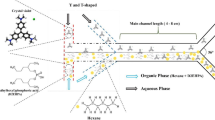Abstract
We demonstrate the complexion of extracting an aromatic organic compound in microchannel system over other conventional methods like batch extraction, microwave assisted extraction and ultrasonic assisted extraction. Extraction studies were carried out for phenol, an aromatic organic compound from dodecane into distilled water. The extraction process is studied for a varying extraction time, microwave energy, percent ultrasonic power and micro channel diameter. Batch extraction is carried out at 25, 50, 100 and 200 rpm, microwave assisted extraction is carried out at 119, 231, 385, 539 and 700 W, ultrasonic assisted extraction is conducted in a 130 W ultrasonicator at a frequency of 20 kHz and amplitude of 10, 20, 30, 40 and 50 % for a varying extraction time of 1, 2, 4, 8, 16 and 32 min. While, the microsystem based extraction was carried out in a circular T junction microchannel. Among the various flow types in a microchannel, slug flow is intensified for its better hydrodynamic and mass transfer properties. Microchannel having diameter 600, 800, 1,000, 1,200 µm is used and compared for better extraction percentage. Experimental results manifested that 600 µm showed better extraction percentage. When comparing the extraction percentage of phenol acquired in microchannel system with other convention methods we observed the following ladder: slug based extraction > ultrasonic assisted extraction > microwave assisted extraction > batch extraction. Also, the microsystem based extraction needed just half of the operation time required by other conventional methods for achieving maximum extraction percentage. This subsequently causes effective usage of chemicals, thereby reducing chemical wastage. And, high efficient extraction can be obtained at very less time.






Similar content being viewed by others
References
Aljbour S, Yamada H, Tagawa T (2010) Sequential reaction–separation in a microchannel reactor for liquid–liquid phase transfer catalysis. Top Catal 53:694–699
Antony R, Nandagopal MSG, Nidhin S, Selvaraju N (2014a) Detection principles and development of microfluidic sensors in the last decade. Microsyst Technol 20:1051–1061
Antony R, Nandagopal MSG, Rangabhashiyam S, Selvaraju N (2014b) Probabilistic neural network prediction of liquid–liquid two phase flows in a circular microchannel. J Sci Ind Res 73:525–529
Burns JR, Ramshaw C (2001) The intensification of rapid reactions in multiphase systems using slug flow in capillaries. Lab Chip 1:10–15
Cai Z-X, Fang Q, Chen H-W, Fang Z-L (2006) A microfluidic chip based liquid–liquid extraction system with microporous membrane. Anal Chim Acta 556:151–156
Chen H, Fang Q, Yin X-F, Fang Z-L (2005) Microfluidic chip-based liquid–liquid extraction and preconcentration using a subnanoliter-droplet trapping technique. Lab Chip 5:719–725
Craveiro AA, Matos FJA, Alencar JW (1989) Microwave oven extraction of an essential oil. Flavour Frag J 4:43–44
Kralj JG, Schmidtb MA, Jensen KF (2005) Surfactant-enhanced liquid–liquid extraction in microfluidic channels with inline electric-field enhanced coalescence. Lab Chip 5:531–535
Kralj JG, Sahoo HR, Jensen KF (2007) Integrated continuous microfluidic liquid–liquid extraction. Lab Chip 7:256–263
Liu A-L, He F-Y, Hu Y-L, Xia X-H (2006) Plastified poly(ethylene terephthalate) (PET)-toner microfluidic chip by direct-printing integrated with electrochemical detection for pharmaceutical analysis. Talanta 68:1303–1308
Loupy A, Petit A, Hamelin J, Texier-Boullet F, Jacquault P, Mathe D (1998) New solvent free organic synthesis using focused microwaves. Synthesis 9:1213–1234
Maruyama T, Kaji T, Ohkawa T, Sotowa T, Matsushita H, Kubota F, Kamiya N, Kusakabe K, Goto M (2004) Intermittent partition walls promote solvent extraction of metal ions in a microfluidic device. Analyst 129:1008–1013
Mary P, Studer V, Tabeling P (2008) Microfluidic droplet-based liquid–liquid extraction. Anal Chem 80:2680–2687
Nandagopal MSG, Antony R, Rangabhashiyam S, Nidhin S, Selvaraju N (2014a) Overview of microneedle system—a third generation transdermal drug delivery approach. Microsyst Technol 20:1249–1272
Nandagopal MSG, Antony R, Rangabhashiyam S, Selvaraju N (2014b) Advance approach on environmental assessment and monitoring—a review. Res J Chem Environ 18:78–90
Nuchter M, Ondruschka B, Jungnickel A, Muller A (2000) Organic processes initiated by non-classical energy sources. J Phys Org Chem 13:579–586
Nuchter M, Muller A, Ondruschka B, Tied A, Lautenschlager W (2003) Microwave-assisted chemical reactions. Chem Eng Technol 26:1207–1216
Nuchter M, Ondruschka B, Bonrath W, Gum A (2004) Microwave assisted synthesis—a critical technology overview. Green Chem 6:128–141
Oerke A, Buttgenbach S, Dietzel A (2014) Micro molding for double-sided micro structuring of SU-8 resist. Microsyst Technol 20:593–598
Sato K, Hibara A, Tokeshi M, Hisamoto H, Kitamori T (2003) Integration of chemical and biochemical analysis systems into a glass microchip. Anal Sci 19:15–22
Streets AM, Huang Y (2013) Chip in a Lab: microfluidics for next generation life science research. Biomicrofluidics. doi:10.1063/1.4789751
Tokeshi M, Minagawa T, Uchiyama K, Hibara A, Sato K, Hisamoto H, Kitamori T (2002) Continuous-flow chemical processing on a microchip by combining microunit operations and a multiphase flow network. Anal Chem 74:1565–1571
Vinatoru M (2001) Mass transfer enhancement in supercritical fluids extraction by means of power ultrasound. Ultrason Sonochem 8:303–313
Acknowledgments
All the authors heartily thank the editor for his moral support. The authors wish to thank the anonymous reviewers and the Editor for their valuable comments and suggestions which improved the quality of the paper. The financial support of National Institute of Technology Calicut, India (Faculty Research Grant Scheme, Grant No: Dean (C&SR)/FRG10-11/0102) is gratefully acknowledged.
Author information
Authors and Affiliations
Corresponding author
Rights and permissions
About this article
Cite this article
Nandagopal, M.S.G., Antony, R. & Selvaraju, N. Comparative study of liquid–liquid extraction in miniaturized channels over other conventional extraction methods. Microsyst Technol 22, 349–356 (2016). https://doi.org/10.1007/s00542-014-2391-5
Received:
Accepted:
Published:
Issue Date:
DOI: https://doi.org/10.1007/s00542-014-2391-5




